

Howard Gardner: ‘Multiple intelligences’ are not ‘learning styles’ The fields of psychology and education were revolutionized 30 years ago when the now world-renowned psychologist Howard Gardner published his 1983 book Frames of Mind: The Theory of Multiple Intelligences,” which detailed a new model of human intelligence that went beyond the traditional view that there was a single kind that could be measured by standardized tests.
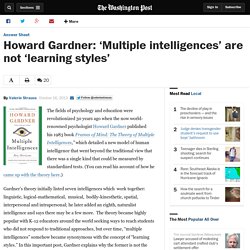
(You can read his account of how he came up with the theory here.) Gardner’s theory initially listed seven intelligences which work together: linguistic, logical-mathematical, musical, bodily-kinesthetic, spatial, interpersonal and intrapersonal; he later added an eighth, naturalist intelligence and says there may be a few more. The theory became highly popular with K-12 educators around the world seeking ways to reach students who did not respond to traditional approaches, but over time, “multiple intelligences” somehow became synonymous with the concept of “learning styles.”
By Howard Gardner Two problems. Problem #2. 1. TEACHING MULTIPLE INTELLIGENCE THEORY: STEP-BY-STEP LESSONS. Multiple Intelligences - Videos, Articles, Resources, Experts. Concept to Classroom: Tapping into Multiple Intelligences - Implementation. Presentations Step-by-step M.I. lesson plan guide Wrap up.
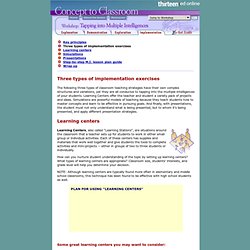
Constructivism as a Paradigm for Teaching and Learning. How will we explore multiple intelligences theory in the classroom?
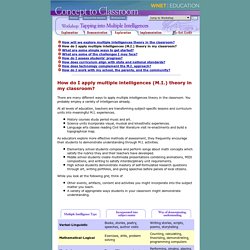
How do I apply multiple intelligences (M.I.) theory in my classroom? What are some simple ways to get started? What are some of the challenges I may face? How do I assess students' progress? Multiple Intelligence Activities for classroom on Pinterest. Multintell. Jilani_Dare_to_Differentiate_through_Choices_ Teaching Learning Styles and Multiple Intelligences to Students. By Harvey F.

Silver, Richard W. Strong and Matthew J. Perini Many teachers who use learning styles and multiple intelligences in their classrooms wonder how important it is for students to know about these models. Experience has taught us that students who understand the models are better able to understand their own learning profiles, to develop flexibility and adaptability in their thinking, and to set realistic goals about minimizing learning weaknesses and maximizing strengths.
When students engage in this kind of “thinking about thinking,” they become more self-directed and are able to select appropriate strategies for particular learning situations. Teaching Students About Learning Styles Demonstration Barb Heinzman of Geneva, New York, led her students through the following hands-on “Apple” demonstration to teach them about perception and judgment: Questioning in Style Figure 6.1. Of course, four-style questioning can be used at any grade level. Figure 6.2. Figure 6.3. Figure 6.4. Multiple Intelligences. Multiple Intelligences Chart. Clip & Save Checklist: Learning Activities That Connect With Multiple Intelligences. Like most teachers, you're probably familiar with Howard Gardner's theory on multiple intelligences — that there are eight different types of intelligence and that these intelligences guide the way we learn and process information.

What you may not be as familiar with is how to apply a multiple intelligence approach to learning in your classroom. Start with this checklist. Use it to refresh your memory on each of the intelligences and pinpoint learning activities that will appeal to your students based on their particular strengths. To involve students in identifying their multiple intelligences, invite them to complete The Connell Multiple Intelligence Questionnaire for Children. They will find it exciting to see the areas they are strongest in, and to understand how these might be affecting their schoolwork. Verbal-Linguistic Intelligence (Word Smart) Big Thinkers: Howard Gardner on Multiple Intelligences. Howard Gardner: We have schools because we hope that someday when children have left schools that they will still be able to use what it is that they've learned.
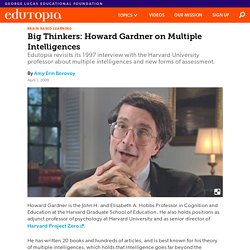
And there is now a massive amount of evidence from all realms of science that unless individuals take a very active role in what it is that they're studying, unless they learn to ask questions, to do things hands-on, to essentially recreate things in their own mind and then transform them as is needed, the ideas just disappear. The student may have a good grade on the exam. We may think that he or she is learning, but a year or two later there's nothing left. The idea of multiple intelligences comes out of psychology. We have this myth that the only way to learn something is read it in a textbook or hear a lecture on it, and the only way to show that we've understood something is to take a short-answer test or maybe occasionally with an essay question thrown in. So let's take the area of science. Birmingham Grid for Learning - Multiple Intelligences (Secondary)
Multiple Intelligences In The Classroom. The story of much recent innovation in education follows a familiar pattern: the theory of an innovative thinker (in this case, Harvard’s Howard Gardner) gets applied by an innovative practitioner (third grade teacher Bruce Campbell), who puts the flesh of action on the bones of thinking.

Along the way, theories get substantiated, the subjects of the successful experiment benefit greatly – and, as Bruce Campbell reports in this self-interview, the experimenter is forever altered. Bruce, together with his wife Linda MacRae-Campbell and Dee Dickinson (Dee and Linda are guest editors for this issue), is currently co-authoring a book titled LearningWorks: Teaching and Learning through the Multiple Intelligences. Contact the Campbells at 19614 Soundview Drive, Stanwood, WA 98292, 206/652-9502. - Margaret Mead In recent years, new definitions of intelligence have gained acceptance and have dramatically enhanced the appraisal of human competencies.
Multiple Intelligences. Enhancing Education: Multiple Intelligences: Definitions and Examples. Concept to Classroom: Tapping into multiple intelligences - Explanation. Theory of multiple intelligences. The theory of multiple intelligences is a theory of intelligence that differentiates it into specific (primarily sensory) "modalities", rather than seeing intelligence as dominated by a single general ability.
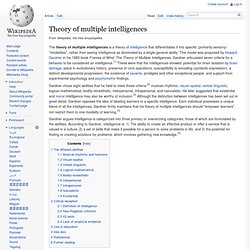
This model was proposed by Howard Gardner in his 1983 book Frames of Mind: The Theory of Multiple Intelligences. Gardner articulated seven criteria for a behavior to be considered an intelligence.[1] These were that the intelligences showed: potential for brain isolation by brain damage, place in evolutionary history, presence of core operations, susceptibility to encoding (symbolic expression), a distinct developmental progression, the existence of savants, prodigies and other exceptional people, and support from experimental psychology and psychometric findings. Gardner argues intelligence is categorized into three primary or overarching categories, those of which are formulated by the abilities. The different abilities[edit] Musical–rhythmic and harmonic[edit] Interpersonal[edit]
Gardner's Multiple Intelligences. Howard Gardner of Harvard has identified seven distinct intelligences.
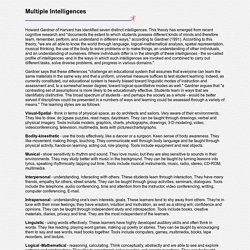
This theory has emerged from recent cognitive research and "documents the extent to which students possess different kinds of minds and therefore learn, remember, perform, and understand in different ways," according to Gardner (1991). According to this theory, "we are all able to know the world through language, logical-mathematical analysis, spatial representation, musical thinking, the use of the body to solve problems or to make things, an understanding of other individuals, and an understanding of ourselves. Toward a More Creative & Holistic Model of Education. Successful education involves seeing each child as a unique and whole human being, concerned about how they think, feel and learn.
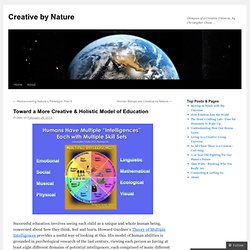
Howard Gardner’s Theory of Multiple Intelligences provides a useful way of looking at this. His model of human abilities is grounded in psychological research of the last century, viewing each person as having at least eight different domains of potential intelligences, each comprised of many different skill sets that can be mastered and developed over time. Unfortunately, current test-driven school reforms pay little attention to Gardner’s holistic view of human beings. They ignore the last 50 years of research in cognitive science, psychology and innovative learner-centered education, focused primarily on a very narrow range of “testable” mathematical, cognitive and linguistic skills in the upper right quadrant of Gardner’s model.
Redefining Smart: Multiple Intelligences. Edutopia reports on the resurgent relevance of Howard Gardner's ground-breaking theory, which changed the game for students and teachers. Credit: iStockphoto Editor's Note (2013): There is no scientific evidence, as of yet, that shows that people have specific, fixed learning styles or discrete intelligences, nor that students benefit when teachers target instruction to a specific learning style or intelligence.
Apps for Multiple Intelligences.